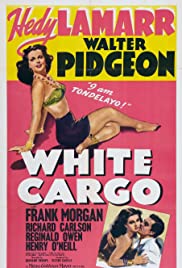
WHITE CARGO
US, 1942, 88 minutes, Black and white.
Hedy Lamarr, Walter Pidgeon, Richard Carlson, Frank Morgan, Reginald Owen, Henry O’ Neill.
Directed by Richard Thorpe.
Seems now a rather ludicrous exotic melodrama. Based on a play and an early talkies film, White Cargo has the atmosphere of steamy African adventures, the touch of Somerset Maugham, for example, Rain and some of the implications of Red Dust. However, the screen play is written in a too rhetorical style with an emphasis on convention and cliche. The characters are generally stereotypes. This means that their interaction, no matter how valid, does not quite work and emphasises the more ludicrous aspects of the melodrama.
Hedy Lamarr looks all glamour in the central role of Tondelayo, her eyes and her teeth sparkle and are lit much more than the rest of her face, giving a cinematic exotic style. Richard Carlson battles bravely with the melodramatic hero. Walter Pidgeon gives a very strong performance and does his best as the hard District Resident. He almost breaks through some of the sillier lines that he is given to say. Frank Morgan gives his usual efficient performance as an alcoholic doctor.
The setting is Africa. The four white men in the area are involved in the rubber industry. The screenplay echoes Empire, racist and prejudice attitudes of the time - 1910. At times 1910 intrudes as when Carlson plays a contemporary record and Tondelayo suddenly apes the Broadway stage dancing style. There is passion and ultimately murder - especially a very casual execution of Tondelayo by Walter Pidgeon. Direction is by Richard Thorpe who was to make a number of effective costume dramas in the fifties: Ivanhoe, Knights Of The Round Table, Quentin Durwood.
1. The entertainment value of this kind of film? In its time? Now? How dated does it seem - why?
2. M.G.M. production and gloss, black and white photography, sets? Stars? The musical score?
3. The establishing of the atmosphere via the flashback? 1910, Africa, isolation. the jungle - how persuasively presented? The heat, pressures and isolation, work? Whites in Africa - and the relative absence of the audience seeing the native population?
4. The plausibility of the plot in terms of theme: isolation? The seductive native girl, her tormenting the whites, the effects of drink, isolation and work and antagonism towards one another? Her exploiting this? The style in which it was done?
5. The focus on Harry ? Walter Pidgeon's strength, his angers? Role as District Resident, antagonism towards Tondelayo? Criticisms of Ashley, the doctor, hostility towards Langford and letting him fall? The confrontations? The discovery of the truth and his forcing Tondelayo to drink the poison? The sketch of the hardness of this kind of man?
6. Hedy Lamarr as Tondelayo - looking exotic, acting as seductive, her consistency and inconsistency of character? Luring Langford, marrying him, exploiting him, tempting Harry, the poisoning and death?
7. Langford - his enthusiasm on arrival, his being green in working with the natives, his decline, drinking, anger, wanting to acclimatise, Tondelayo and his lapse, marriage, illness, death?
8. The gallery of minor characters - Ashley and his collapse? The doctor and his continued drinking and isolation, the Reverend Roberts and his inability to help the men in any significant way, the skipper and the arrival of the ship?
9. The scenes of work on the rubber plantations? The role of the natives and the exploitive comments? Racist comments?
10. The scenes between the men, especially with the meal when the skipper arrived, the singsong?
11. The familiarity of this kind of melodrama - and its ability to date easily?